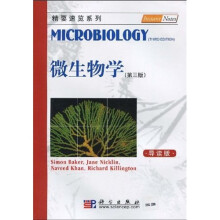微生物学(导读版)(第3版)

目 录内容简介
目录前言缩略词A 微生物世界 (1)A1 微生物世界 (1)B 系统学 (5)B1 原核生物的系统学 (5)B2 细菌的鉴定 (7)B3 基于rRNA基因序列的系统发育推理 (10)C 微生物学 (13)C1 发现和历史 (13)C2 原核生物的多样性 (15)C3 细菌的实验室培养 (18)C4 微生物计数 (21)C5 微生物观察 (25)C6 原核生物的主要类群 (32)C7 典型原核细胞的组成 (41)C8 细菌的细胞壁 (46)C9 细胞分裂 (52)C10 细菌的鞭毛及其运动 (56)C11 原核生物及其环境 (59)D 微生物的生长 (65)D1 微生物生长的测量 (65)D2 实验室中的分批培养 (72)D3 大规模培养和连续培养 (76)E 微生物的代谢 (81)E1 酶学 (81)E2 异养微生物代谢途径 (87)E3 电子传递、氧化磷酸化和脂肪酸β唱氧化 (95)E4 自养微生物代谢 (101)E5 生物合成途径 (107)F 原核生物的DNA和RNA代谢 (113)F1 DNA——初级信息大分子 (113)F2 基因组 (117)F3 核酸的结构 (121)F4 杂交 (126)F5 DNA复制 (132)F6 转录 (139)F7 RNA和遗传密码 (149)F8 翻译 (154)F9 信号转导和环境感应 (158)F10 突变 (162)F11 DNA修复 (169)F12 细胞间的DNA转移 (173)F13 重组 (177)F14 噬菌体 (181)F15 质粒 (186)F16 细胞DNA和RNA的操作 (189)G 工业微生物学 (201)G1 原核生物在工业中的应用 (201)H 细菌感染 (205)H1 人类的细菌感染 (205)H2 细菌感染: 类型、侵入部位、传播方式、细菌感染出现/扩散的诱发因素及其共同特征 (217)H3 细菌感染的发病机制及毒力 (222)H4 细菌毒素 (226)H5 一种模式细菌病原体——大肠杆菌 (232)H6 人类的防御机制 (240)H7 细菌对免疫系统的逃避 (244)H8 细菌感染的控制 (248)H9 细菌生物武器 (252)I 真核微生物概述 (257)I1 分类学 (257)I2 真核细胞结构 (260)I3 细胞分裂与倍增 (267)J 真菌及其相关门类 (273)J1 真菌的结构与生长 (273)J2 真菌的营养 (278)J3 真菌的繁殖 (281)J4 有益影响 (288)J5 有害影响 (292)K 绿藻门和原生生物 (295)K1 分类学与结构 (295)K2 营养与代谢 (304)K3 生活史 (310)K4 有益影响 (318)K5 有害影响 (321)K6 寄生性原生生物 (323)L 病毒 (343)L1 病毒的结构 (343)L2 病毒的分类学 (348)L3 病毒的蛋白质 (353)L4 病毒的核酸 (359)L5 细胞培养与病毒的生长 (366)L6 病毒的检测 (370)L7 病毒的复制 (374)L8 病毒感染 (380)L9 病毒与免疫系统 (386)L10 病毒疫苗 (390)L11 抗病毒的化学疗法 (394)L12 植物病毒 (399)L13 朊病毒和传染性海绵状脑病 (404)进一步阅读的文献 411索引 413CONTENTSPrefaceAbbreviationsSection A The microbial world 1A1 The microbial world 1Section B Systematics 5B1 Prokaryotic systematics 5B2 Identification of bacteria 7B3 Inference of phylogeny from rRNA gene sequence 10Section C Microbl0108y 13C1 Discovery and history 13C2 Prokaryotic diversity 15C3 Culture of bacteria in the laboratory 18C4 Enumeration of microorganisms 21C5 Looking at microbes 25C6 The major prokaryotic groups 32C7 Composition of a typical prokaryotic cell 41C8 The bacterial cell wall 46C9 Cell division 52C10 Bacterial flagella and movement 56C11 Prokaryotes and their environment 59Section D Microbial growth 65Dl Measurement of microbial growth 65D2 Batch culture in the laboratory 72D3 Large-scale and continuous culture 76Section E Microbial metabolism 81E1 Enzymology 81E2 Heterotrophic pathways 87E3 Electron transport, oxidative phosphorylation and β-oxidation of fatty aads 95E4 Autotrophic reactions 101E5 Biosynthetic pathways 107Section F Prokaryotic DNA and RNA metabolism 113F1 DNA - the primary information macromolecule 113F2 Genomes 117F3 Structure of nucleic acids 121F4 Hybridizahon 126F5 DNA replication 132F6 Transcription 139F7 RNA and the genetic code 149F8 Translation 154F9 Signal transduction and environmental sensing 158F10 Mutahon 162F11 DNA repair 169F12 Transfer of DNA between cells 173F13 Recombination 177F14 Bacteriophage 181F15 Plasmids 186F16 Manipulation of cellular DNA and RNA 189Sechon G Industrial nucrobiology 201G1 Prokaryotes in industry 201Section H Bacterial infechons 205H1 Human bacterial infechons 205H2 Bacterial infections: types, portals of entry, modes of transmission, contributing factors in their emergence/spread and common features in bacterial infections 217H3 Pathogenesis and virulence of bacterial infections 222H4 Bacterial toxins 226H5 Escherichia coli as a model bacterial pathogen 232H6 Human defence mecharusms 240H7 Bacterial evasion of immune defences 244H8 Control of bacterial infections 248H9 Bacteria as biological weapons 252Section I Eukaryotic microbes: an overview 257I1 Taxonomy 257I2 Eukaryotic cell structure 260I3 Cell division and ploidy 267Section J The fungi and related phyla 273J1 Fungal structure and growth 273J2 Fungal nutrition 278J3 Reproduction in fungi 281J4 Beneficial effects 288J5 Detrimental effects 292Section K Chlorophyta and protista 295Kl Taxonomy and structure 295K2 Nutrition and metabolism 304K3 Life cycles 310K4 Beneficial effects 318K5 Detrimental effects 321K6 Parasitic protista 323Section L The Viruses 343L1 Virus structure 343L2 Virus taxonomy 348L3 Virus proteins 353L4 Virus nucleic aads 359L5 Cell culture and virus growth 366L6 Virus assay 370L7 Virus replication 374L8 Virus infection 380L9 Viruses and the immune system 386L10 Virus vaccines 390L11 Antiviral chemotherapy 394L12 Plant viruses 399L13 Prions and transmissible spongifo
目 录内容简介
“精要速览系列(Instant Notes Series)”丛书是国外教材“Best Seller”榜的上榜教材。该系列结构新颖,视角独特;重点明确,脉络分明;图表简明清晰;英文自然易懂,被国内多所重点院校选用作为双语教材。 《微生物学 第三版 导读版》第3版沿袭第2版的编写特点,但对《微生物学 第三版 导读版》进行了全面的修订。《微生物学 第三版 导读版》分为12个部分,包括微生物的细胞结构、分类、代谢、遗传、生态、感染和免疫以及真菌、藻类、原生生物和病毒等内容,增加了系统学、微生物学、RNA代谢、细胞DNA和RNA操作、细菌生物武器、寄生性原生生物等章节。使第3版强化了普通微生物学部分,突出了细菌学内容,同时更加关注从分子生物学角度阐明微生物学相关知识,并将微生物学的理论知识与实验操作有机地结合在一起,既全面、重点地概括了微生物学的基本概念和原理,又突出介绍了本学科发展的前沿热点问题。
比价列表
公众号、微信群
 缺书网
缺书网微信公众号
 扫码进群
扫码进群实时获取购书优惠







